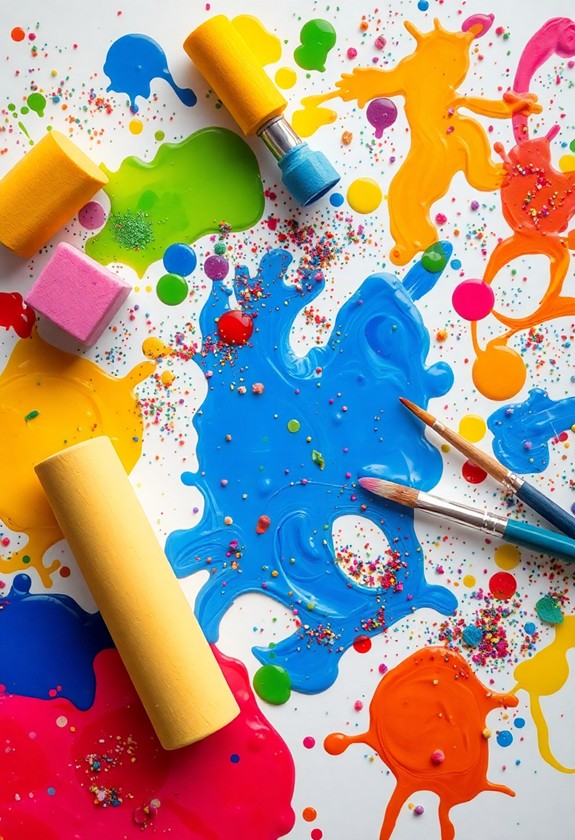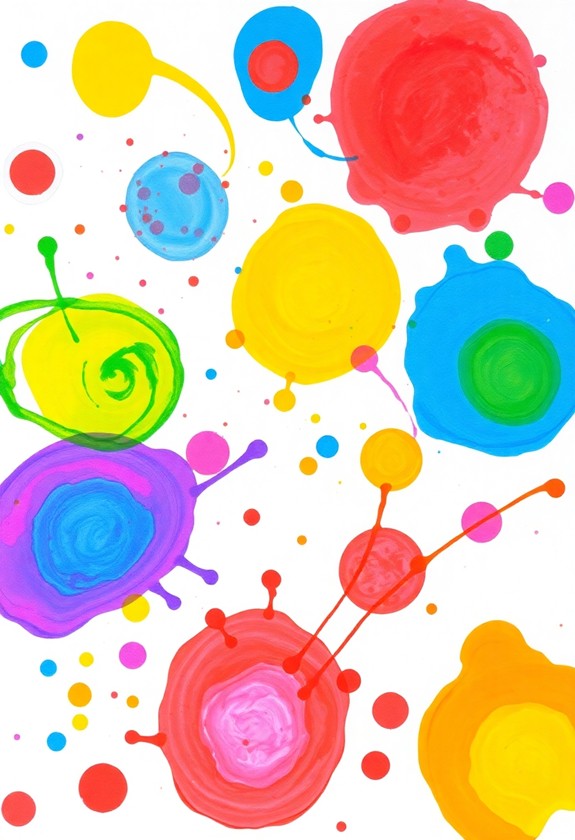Get ready for some messy fun with these 7 sensory art projects your toddler will absolutely love! Let them squish pudding paint, mix colors in shaving cream, or create spaghetti masterpieces. For active little ones, try bubble wrap stomping paint – it's a blast! Sculpt with edible playdough, make cool patterns with melting ice cube paints, or whip up some muddy masterpieces outdoors. These activities are perfect for developing fine motor skills, encouraging creativity, and stimulating the senses. Plus, they're easy to set up and clean up! Prepare for giggles, squeals, and maybe a few colorful messes as you investigate these exciting artistic adventures together.
Creative Highlights
- Finger painting with pudding offers a tasty, sensory-rich experience for toddlers with easy setup and cleanup.
- Shaving cream color mixing promotes hand-eye coordination and color recognition while providing a unique texture.
- Spaghetti noodle art encourages creativity and fine motor skills development through squishing and swirling colored noodles.
- Bubble wrap stomping paint engages the whole body, creating colorful prints while promoting gross motor skills.
- Edible playdough sculpting develops fine motor skills and creative expression while being safe for toddlers to explore.
Finger Painting With Pudding
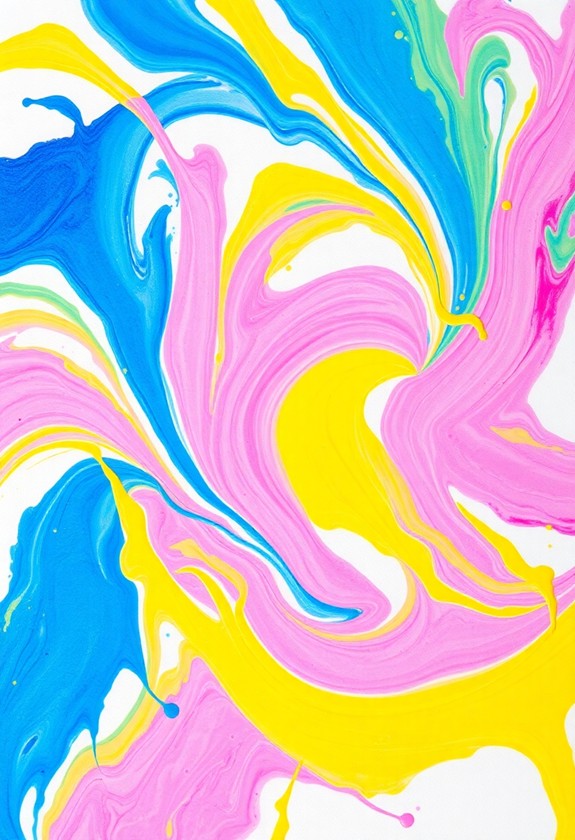
Countless toddlers love getting messy, and finger painting with pudding is a perfect way to engage their senses. It's easy, fun, and deliciously edible! Creative summer art activities like this one are perfect for keeping little ones entertained during the warmer months. Here's how to set up this tasty art activity:
- Choose pudding flavors (chocolate, vanilla, or go wild with strawberry!)
- Prepare pudding according to package instructions
- Let it cool in the fridge
- Spread pudding on a tray or table
- Let your little artist loose!
Watch as your toddler squishes, smears, and creates masterpieces with their fingers. They'll love the cool, smooth texture and yummy smell. Plus, it's totally okay if they sneak a taste! Clean-up is a breeze too – just wipe it away or let them lick their fingers clean. This pudding painting party is certain to be a hit with your tiny Picasso!
Shaving Cream Color Mixing
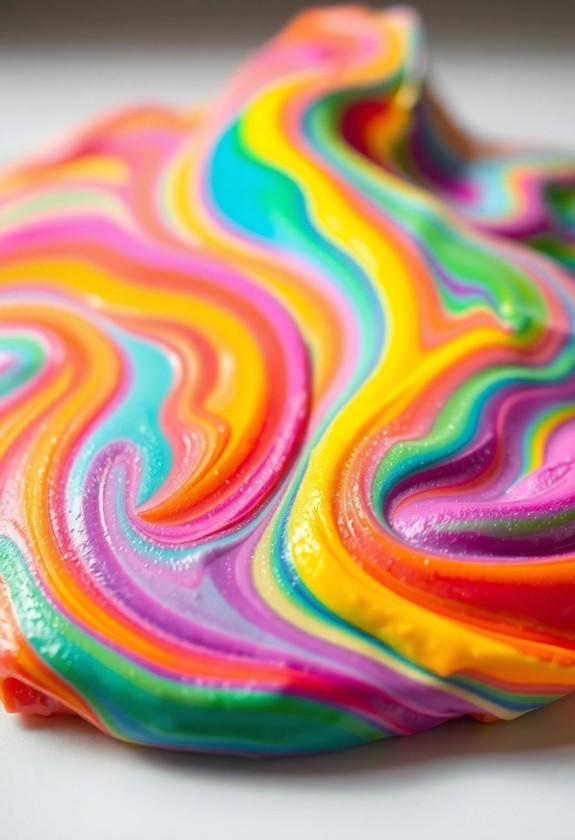
Another fun and messy sensory art project for toddlers is shaving cream color mixing. It's so easy to set up! Just squirt some shaving cream onto a tray or table, and add drops of food coloring. Your little one will love swirling and smearing the colors together, creating a rainbow of foamy fun! This activity is perfect for promoting hand-eye coordination and color recognition, similar to using washable dot markers. The soft texture likewise provides a unique sensory experience for little hands.
Here's what you'll need:
- Shaving cream (unscented)
- Food coloring
- Large tray or plastic tablecloth
Let your toddler plunge in and discover! They'll be amazed as they watch the colors blend and change. It's like magic right before their eyes! Additionally, the soft, fluffy texture is irresistible to little hands. Don't worry about the mess – shaving cream cleans up easily with water. This activity is a guaranteed way to keep your tot engaged and giggling!
Spaghetti Noodle Art

Plunge into the world of spaghetti noodle art with your toddler for a unique sensory experience. It's a pasta-tively amazing activity! Here's how to get started:
- Cook a batch of spaghetti noodles
- Divide the noodles into separate bowls
- Add food coloring to each bowl
- Mix well until noodles are lively
Now, let your little one's creativity run wild! They can squish, squash, and swirl the noodles on paper or a tray. Watch as they create colorful masterpieces with their hands or tools like forks and spoons. This activity is perfect for developing fine motor skills and promoting creativity, much like the Christmas craft kits designed for toddlers.
But wait, there's more! Try these fun variations:
- Add glitter for extra sparkle
- Use scented oils for an olfactory twist
- Mix in small pasta shapes for texture
This saucy activity isn't just fun – it's also great for developing fine motor skills and sensory exploration. So, get ready to noodle around with your tot!
Bubble Wrap Stomping Paint
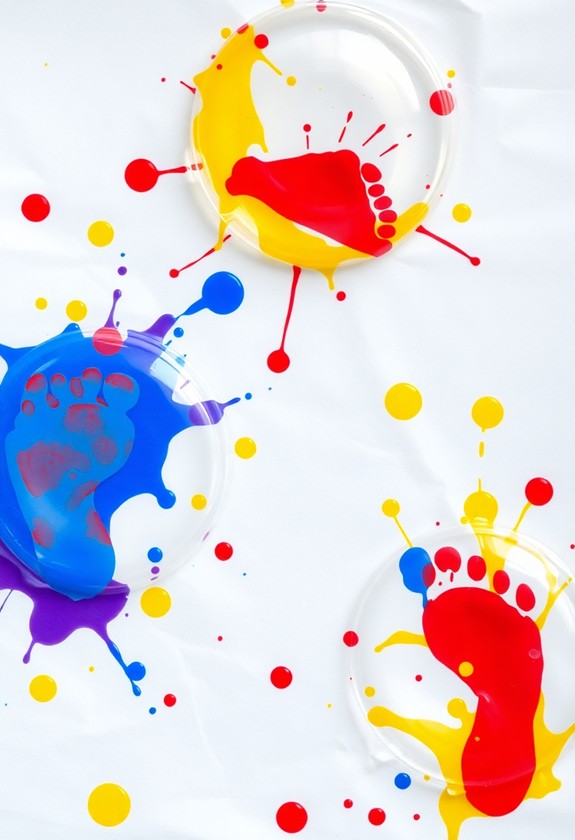
As spaghetti art delights the hands, bubble wrap stomping paint engages the whole body. Get ready for a popping good time! Here's what you'll need:
- Large sheet of bubble wrap
- Washable, non-toxic paint
- Paper or canvas
- Enthusiastic toddler feet
Lay out the bubble wrap on a safe surface and dollop different colors of paint onto it. Now, let your little one stomp away! Watch their eyes light up as they create a masterpiece with their toes. The bubbles will burst, spreading paint and giggles everywhere. This activity is perfect for sensory exploration and can be adapted for children with various sensory sensitivities by adjusting paint textures or providing a quiet space for crafting.
Once they're done, carefully lift the bubble wrap and press it onto paper or canvas. Voila! You've got a bubbly, beautiful print. This activity is a blast for sensory development and gross motor skills. Plus, it's a guaranteed way to tire out energetic toddlers. Talk about popping with creativity!
Edible Playdough Sculpting
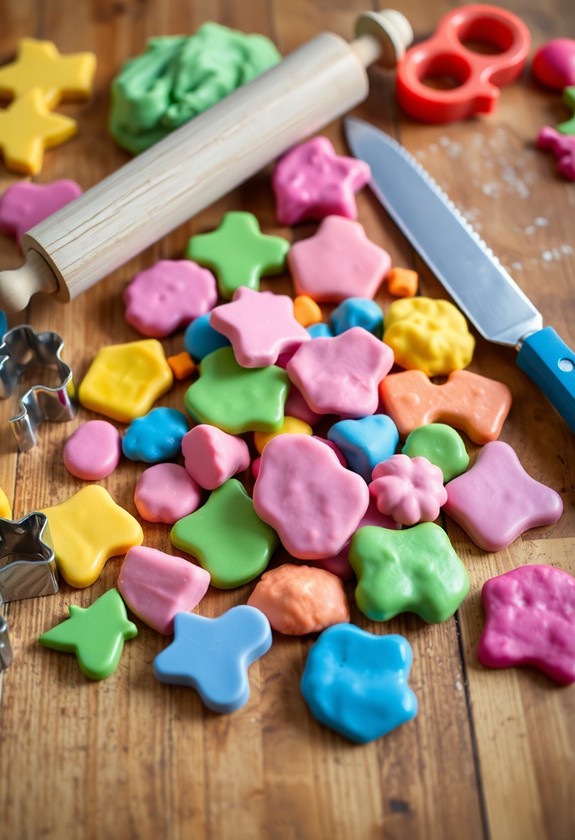
Knead, squish, and mold your way to sensory bliss with edible playdough sculpting. This delightful activity is a feast for the senses and safe for curious little mouths! Here's how to whip up this tasty treat:
- Mix 1 cup flour, 1/4 cup salt, and 2 tbsp oil
- Add 1/2 cup water and food coloring
- Knead until smooth
Now, let your toddler's imagination run wild! They can create:
- Colorful animals
- Miniature vistas
- Silly faces
And the best part? It's totally okay if they take a little nibble! This doughy delight isn't just fun to play with – it's a great way to develop fine motor skills and creativity. Cognitive development is improved through this hands-on activity, promoting problem-solving abilities and self-expression. Plus, you'll have a ball watching your little one squish, roll, and shape their edible masterpieces. It's time to get your hands doughy!
Ice Cube Painting

On a hot summer day, ice cube painting offers a rejuvenating twist on traditional art activities. It's super easy and so much fun! Here's what you'll need:
- Ice cube trays
- Food coloring
- Popsicle sticks
- Thick paper
Mix food coloring with water, pour into trays, add sticks, and freeze. Voilà! You've got colorful ice paints!
Now for the cool part: Let your toddler go wild! As they drag the melting cubes across the paper, watch their eyes light up. The icy trails create unique patterns and blend colors in surprising ways. It's like magic!
But wait, there's more! Try adding salt for a frosty effect, or use scented oils for an aromatic adventure. Your little Picasso will be thrilled with this chill-tastic art experience!
Mud Pie Creations

Nothing beats the tactile joy of making mud pies! This messy masterpiece is a toddler's dream come true. You'll need:
- A patch of dirt
- Water
- Plastic containers or molds
- Mixing tools (spoons, sticks)
- Optional: leaves, pebbles, or flowers for decoration
Start by choosing a spot outside where it's okay to get dirty. Mix dirt and water in a container until you've got a thick, gooey consistency. Let your little one squish, pat, and mold the mud into various shapes. Use plastic containers as molds for perfectly round pies, or let their imagination run wild with freeform creations!
Encourage exploration by adding natural elements like leaves or pebbles. And don't forget to name their mud-sterpieces! This activity isn't just fun – it's a muddy good time that helps develop sensory skills and creativity.
Curious Little Questions
How Can I Protect My Furniture During Messy Art Projects?
Protect your furniture during messy art projects with these fun tricks! First, lay down a waterproof tarp or old sheets to catch spills. Cover tables with plastic tablecloths for easy cleanup. Use painter's tape to secure newspaper or kraft paper to walls and floors. Don't forget to dress your little artists in old clothes or smocks! For extra protection, create a designated "art zone" away from fancy furniture. Remember, messy art is all about creativity, so don't stress too much about perfection!
What Age Is Appropriate to Start Messy Sensory Art Activities?
Time flies in relation to messy art! You can start introducing sensory activities as early as 6 months old. But don't worry, it's never too late to jump in! Here's a quick guide:
- 6-12 months: Simple textures, like touching soft fabrics
- 1-2 years: Finger painting and play dough
- 2-3 years: Water play and sand art
- 3+ years: More complex projects, like slime-making
Are There Alternatives for Children With Food Allergies or Sensitivities?
You've got plenty of options for kiddos with allergies or sensitivities. Don't worry, the fun doesn't have to stop! Try these awesome alternatives:
- Use sand, pebbles, or kinetic sand instead of food-based materials
- Experiment with water beads or water-based slime
- Create sensory bins with natural items like leaves, twigs, and flowers
- Try textured fabrics or foam shapes for tactile exploration
How Do I Encourage a Reluctant Child to Participate in Messy Play?
You're about to initiate an epic adventure to transform your reluctant child into a messy play champion! Start small, and make it irresistibly fun. Let them watch you get messy first, then invite them to join. Use their favorite toys or themes as bait. Try:
- Gradual exposure: Start with less messy activities
- Positive reinforcement: Praise their efforts
- Make it a game: "Can you find the hidden treasure in the slime?"
What Are the Best Methods for Cleaning up After Messy Art Projects?
Cleaning up after messy art projects can be a breeze! Here are some excellent tips:
- Get everyone involved – make it a fun team effort!
- Use baby wipes for quick clean-ups on skin and surfaces
- Keep a spray bottle of soapy water handy for stubborn spots
- Lay down old newspapers or plastic sheets before starting
- Wear old clothes or smocks to protect outfits
- Have a dedicated "messy art" area for easier containment

